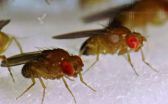(Press-News.org) How do new genes arise? Current research shows that so-called "orphan genes" may appear as if by magic as a result of mutations in segments of DNA that previously had no function. Orphan genes were first discovered in the fruit fly but are found in all organisms, including man. Strikingly, up to 30 per cent of the total number of genes in an organism may be orphans and these genes may rapidly acquire functions. Scientists from the Institute of Population Genetics of the University of Veterinary Medicine, Vienna (Vetmeduni) have now investigated the fate of orphan genes. They show for the first time that orphan genes are frequently lost and consider the factors the influence the "survival" of the young genes.
Young orphans are at greatest risk
Together with Christian Schlötterer, the Head of the Institute, and other colleagues, Nicola Palmieri investigated the genes in a European species of fruit fly (Drosophila pseudoobscura). The scientists compared the genetic sequence of five related strains of the species, looking for orphan genes and examining the life cycles of the various genes in the fly genome. They discovered that most orphan genes persist for relatively few generations. As Schlötterer explains, "Some genes last for a long time through the evolution of species: these are known as conserved genes. Orphan genes represent the exact opposite: they come and go. Interestingly the youngest orphan genes seem to disappear the fastest. Orphan genes that are 'older' are more likely to remain in the genome."
The researchers identified a number of factors that determine the length of time a young gene remains in a population. Active genes, i.e. those that produce a large amount of RNA, seem more likely to be retained than less active genes; and genes that are more active in males than in females also persist for longer.
Life on the X chromosome: short and sweet
Another important factor is the precise position where an orphan gene is located. When a new gene arises on the X chromosome (males have one X chromosome and females two) it is likely to cease functioning much faster than genes that arise on other chromosomes. Surprisingly, though, there are more orphans on the X chromosome than at other sites in the genome. It is currently unclear why this is so, despite the apparent existence of a mechanism that makes it hard for orphan genes to "survive" on the X chromosome. Life on the X chromosome may be short but it is clearly attractive.
Important tools for evolution
Schlötterer is keen to emphasize the importance of orphan genes for evolution. "Orphan genes are probably extremely important for rapid, short-term adaptations, when a species needs something new and innovative. When they are no longer needed they can be quickly removed from the genome." Recent work in another group has shown how orphan genes can arise: Palmieri and Schlötterer's work now completes the picture by showing how and when they disappear.
INFORMATION:
The article „The life cycle of Drosophila orphan genes", by Nicola Palmieri, Carolin Kosiol and Christian Schlötterer was published in the journal eLife.
DOI: 10.7554/elife.01311
http://arxiv.org/abs/1401.4956
About the University of Veterinary Medicine, Vienna
The University of Veterinary Medicine, Vienna is the only academic and research institution in Austria that focuses on the veterinary sciences. About 1200 employees and 2300 students work on the campus in the north of Vienna, which also houses the animal hospital and various spin-off-companies. http://www.vetmeduni.ac.at
Scientific Contact:
Prof. Christian Schlötterer
Institute of Population Genetics
University of Veterinary Medicine, Vienna (Vetmeduni Vienna)
T +43 1 20577-4300
christian.schloetterer@vetmeduni.ac.at
Released by:
Susanna Kautschitsch
Science Communication | Public Relations
Veterinärmedizinische Universität Wien (Vetmeduni Vienna)
Veterinärplatz 1, 1210 Wien
T +43 1 25077-1153
susanna.kautschitsch@vetmeduni.ac.at
http://www.vetmeduni.ac.at
http://www.facebook.at/vetmeduni.vienna
http://twitter.com/vetmedunivienna (@VetmeduniVienna)
In search of lost genes
2014-02-18
ELSE PRESS RELEASES FROM THIS DATE:
HIV drug used to reverse effects of virus that causes cervical cancer
2014-02-18
A commonly-used HIV drug has been shown to kill-off the human papilloma virus (HPV) that leads to cervical cancer in a world-first clinical trial led by The University of Manchester with Kenyatta National Hospital (KNH) in Nairobi.
Drs Ian and Lynne Hampson, from the University's Institute of Cancer Sciences and Dr Innocent Orora Maranga, Consultant in Obstetrics and Gynaecology at KNH in Nairobi examined Kenyan women diagnosed with HPV positive early stage cervical cancer who were treated with the antiviral HIV drug lopinavir in Kenya.
The study looked at 40 women ...
Leeds researchers build world's most powerful terahertz laser chip
2014-02-18
A paper in the Institution of Engineering and Technology's (IET) journal Electronics Letters reports that the Leeds team has exceeded a 1 Watt output power from a quantum cascade terahertz laser.
The new record more than doubles landmarks set by the Massachusetts Institute of Technology (MIT) and subsequently by a team from Vienna last year.
Terahertz waves, which lie in the part of the electromagnetic spectrum between infrared and microwaves, can penetrate materials that block visible light and have a wide range of possible uses including chemical analysis, security ...
The conditions for a society to become a democracy are analyzed
2014-02-18
This news release is available in Spanish. In view of the changes that have taken place in Europe,JuleGoikoetxea, a lecturer at the UPV/EHU's Faculty of Social Sciences and Communication, has been conducting research into "the conditions needed for a people to become a democracy or sustain its democratisation process over time."The study has been published in the specialised journal Nationalities Papers.
According to Goikoetxea, nation is not synonymous with demos: "The nation is the will, socially and historically articulated, that a group has in order to be a political ...
Researchers shed new light on the genetic history of the European beaver
2014-02-18
An international team of scientists has used detailed analysis of ancient and modern DNA to show that the distribution and lack of genetic diversity among modern European beavers is due largely to human hunting.
The research, which was led by University of York researcher Professor Michi Hofreiter, provides important new insights into the genetic history of the Eurasian beaver Castor fiber. Crucially, it shows the European beaver has been strongly affected by expanding human populations for many thousands of years.
The researchers say that centuries of hunting, rather ...
Surprising survey: Most small businesses remain silent rather than report employee theft
2014-02-18
In a recent survey of small businesses, a University of Cincinnati criminal justice researcher has found that only 16 percent of those that have experienced theft by employees actually reported that theft to the police.
That's even though 64 percent of the small businesses surveyed reported experiencing employee theft.
These are some of the findings in a survey of small businesses that examined the incidence of employee theft, how often it was reported, the types of goods taken by employees, the types of employees most likely to commit theft, and the reasons the business ...
Einstein's conversion from a static to an expanding universe
2014-02-18
Until 1931, physicist Albert Einstein believed that the universe was static. An urban legend attributes this change of perspective to when American astronomer Edwin Hubble showed Einstein his observations of redshift in the light emitted by far away nebulae—today known as galaxies. But the reality is more complex. The change in Einstein's viewpoint, in fact, resulted from a tortuous thought process. Now, in an article published in EPJ H, Harry Nussbaumer from the Institute of Astronomy at ETH Zurich, Switzerland, explains how Einstein changed his mind following many encounters ...
Daily walk of just 3km can reduce risk of hospitalization for respiratory problems
2014-02-18
New research in Respirology shows that suffers of Chronic obstructive pulmonary disease (COPD) can reduce their risk of being hospitalized with severe attacks, by maintaining an exercise regime of walking between three to six kilometers a day.
COPD, a term which includes chronic bronchitis and emphysema, results in breathing difficulties due to long-term lung damage. Severe symptoms (eCOPD), caused by a sudden loss of lung function, can be life threatening.
543 COPD patients were recruited from five Spanish respiratory clinics and their exercise levels were calculated ...
Magnesium may protect against hip fractures
2014-02-18
Drinking water with a relatively high concentration of magnesium protects against hip fractures, according to results of a study from the Norwegian Institute of Public Health.
There are considerable variations in the quality of drinking water in Norway. The researchers studied variations in magnesium and calcium levels in drinking water between different areas, as these are assumed to have a role in the development of bone strength. They wanted to examine whether there was a correlation between magnesium and calcium concentrations in drinking water and the incidence ...
Beauty & bacteria: Slim, attractive men have less nasal bacteria than heavy men
2014-02-18
Do attractive traits tell us anything about a person's reproductive health? New research in the American Journal of Human Biology reveals a link between Body Mass Index (BMI) and the amount of bacteria colonizing noses. The results show that heavier men harbor more potentially pathogenic species of bacteria in their nose, compared with slimmer, more traditionally attractive men.
"According to an evolutionary point of view, traits related to attractiveness are supposed to be honest signals of biological quality," said Dr. Boguslaw Pawlowski. "We analyzed whether nasal ...
Malnutrition decreases effectiveness of HIV treatment in pregnant African women
2014-02-18
In Uganda the prescription of three antiretroviral (ARV) drugs, which aim to suppress the virus to prevent disease progression, have resulted in huge reductions in HIV mortality rates. However, disease is not the only scourge in Uganda, and a new study in The Journal of Clinical Pharmacology explores the impact food insecurity may have on treating pregnant women.
A U.S-Ugandan research team explored the affect pregnancy and malnutrition can have on the administration of lopinavir/ritonavir (LPV/r) and efavirenz (EFV) drugs among HIV-infected women in Tororo, Uganda.
Blood ...



